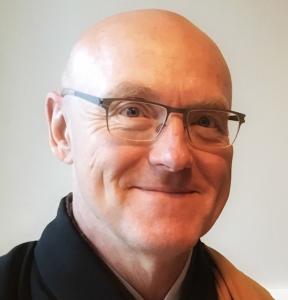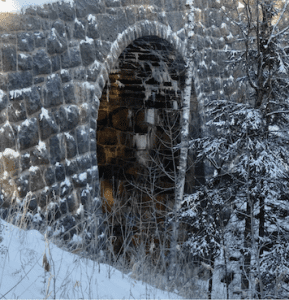Deep, Dark, Nurturing Waters
This post is about practicing after kenshō, and even after having completed many kōans post-kenshō. Following Rújìng (Dōgen’s teacher), I will share two of the most fascinating, complexly interrelated kōans in the whole huge traditional collection of fascinating kōans, ideal for the phase of training known as “advancing practice.” Rújìng says that these kōans test practitioners to their very limits.
Like any kōans, the two that are the focus here are profoundly disruptive to the divided mind. Ryōun Yamada Rōshi writes about kōans in general, “No amount of explanation will suffice to ‘pass’ a kōan. If one can grasp clearly and experientially the true self presented in the kōan then one can spontaneously manifest that true self. So how is this done? There is only one way. One must become that true self totally.” (1)
However, unlike most writing nowadays, including my own recent post, How to Break Through Mu, that are directed toward the early stages of the path, this post is primarily for those who’ve moved into the deep, dark, nurturing waters of the process, and perhaps have completed a kōan curriculum (aka, kōan shitsunai) with a qualified Zen teacher, even receiving so-called final authorization or inka shomei (印可証明, literally, “evidence of the mark”).
It is a common misconception, that passing through mu (i.e., one’s initial kenshō), is the end of the matter. In fact, it is the beginning of the process. As the Sōtō master Dōgen Zenji puts it in his Fukanzazengi:
“Suppose you are confident in your understanding and rich in enlightenment, gaining the wisdom that knows at a glance, attaining the way and clarifying the mind, arousing an aspiration to reach for the heavens. You are playing in the entranceway but are still short of the vital path of emancipation.” (2)
Similarly, the Rinzai master Tōrei Enji (1721–1792) lays out the matter of advancing practice:
“Such cases as Zhàozhōu’s dog have from the beginning presented the matter of advancing practice. This is no small matter, for when a trainee starts with sanzen on Zhàozhōu’s dog, and on reaching the gate, suddenly attains, then entering into true nature is provisionally possible by virtue of the keyword. However, they have not yet come to understand the profound meaning…. Because the habit of delusion goes deep, when it comes to beginning advancing practice in Zen, rather than completing it, they give up halfway.” (3)
Don’t give up halfway!
Even after receiving dharma transmission and inka shomei, it is vital to continue the work. After completing a kōan curriculum, I know some practitioners who’ve gone back to the beginning and done the whole thing again. And then again, even after having become fully authorized Zen teachers. My way, though, has been to find kōans that I haven’t worked through in the kōan curriculum that tingle with light, and give myself to them.
Meidō Moore Rōshi says it so well here:
Whatever lineage path you’re on, at this stage, advancing practice is like Wúmén’s comment to The No Gate Barrier, Case 44: Bājiāo’s Walking Staff, “It supports you as you cross the water over the Broken Bridge. It is your companion, returning to the village, no moon.”
But, hey, if you haven’t passed through the mu barrier (provisionally), or completed a kōan curriculum, and yet are curious about the kōan process of advancing practice, you are very welcome to read along.
That said, it took a couple months for me to translate these two kōans and live with them in order to start to really appreciate them, so it might take a bit of work on your part as well. A quick scroll will probably not do it. And yet I can testify that the kōans you are about to be introduced to (at long last) are true bodymind blowers, like those fireworks that seem to linger in the darkness of the night sky, and then sizzle alive.
That Rújìng pulled these needles out of the kōan haystack is enormously cool and speaks volumes about his radiant light and dark subtlety. These kōans are, afterall, about meeting people and manifesting buddhadharma. Surprisingly, they are not a part of any kōan curriculum that I know of, although Dōgen did include them in his Three Hundred Kōan Shobogenzo. (5)
So let’s get to it
In the section of “The Record of Rújìng, While Abiding at Qingliang Temple in the City of Jiankang,” Rújìng presents this brief instruction (6):
“Again, from his seat, Sānshèng raised this, saying, ‘Meet people, then, in that case, manifest. Manifest, then, not for people.’
“Xīnghuà said, ‘I meet people, then, not manifest. Manifest, then, in that case, for people.’
[Rújìng said,] “These two kōans test kesa-wearing monks to their limit. It’s difficult to fix your gaze on them. [So] fix your gaze on them!”
That’s it. There they are. You may not be awestruck – yet – so let’s work ’em, work ’em, work ’em.
What’s going on here
In one of my first meetings with Harada Tangen Rōshi, I asked him, “What is the essence of your teaching?”
In his rough English, he said, “To each, according…,” as he trailed off, nodding his head knowingly. Don’t overlook the profound truth for advancing practice right here!
As for the above kōans, first, you may have noticed that the translation is rougher than Tangen Rōshi’s English, and, frankly, difficult to understand. Sorry about that. It’s the result of my trying to stomp my feet in time with the structure and the word play that’s present in the original Chinese.
Before I say more on that, though, let’s take a quick look at who Sānshèng and Xīnghuà were. The Cáodòng/Sōtō master Rújìng’s two kōans for advancing practice involve two direct successors of Línjì/Rinzai – Sānshèng and Xīnghuà.
Who was Sānshèng? Línjì called Sānshèng a blind donkey just before he died. Quite a claim to fame! It was Sānshèng who went on to compile Línjì’s breying and made it into the Línjì lu (The Record of Linji; Japanese, Rinzai roku).
In addition, Sānshèng appears in at least a couple important cases in our kōan curriculum – Blue Cliff Record (J. Hekiganroku), Case 49 (”When a golden scaled fish has passed through the net, what does it use for food?”) and one of the most wonderfully playful cases in the curriculum, Blue Cliff Record, Case 68 (Yangshan asked, “What is your name?”).
And how about Xīnghuà? He was junior to Sānshèng in Línjì’s community. It is through Xīnghuà, though, that all surviving Línjì lineages flow, and in our case, through Xūtáng, Daiō, Hakuin, Daiun Sogaku and to those of us who are successors of the Harada-Yasutani line.
In terms of other kōans that Xīnghuà appears in, see The Record of Going Easy (J. Shoyoroku), “Case 97: Emperor Guang’s Helmet.”
Playing awakening, awakening play
Now that you have a little sense of who’s involved in these cases, I’m compelled to address the fascinating process behind what was said, that is, how what was said was said. Sānshèng’s utterance, you see, uses just ten words, while Xīnghuà uses eleven – the same ten words Sānshèng uses, but he begins with “I”, the eleventh word, for a total of twenty-one words between the two kōans. That little “I,” by the way, is very significant to the embodiment of these kōans.
Of those twenty-one words, there are only eight different words: “Person” (人), “then” (則), and “manifest” (出) are each used four times; “meet” (逢), “not” (不), “in that case” (便), and “for” (為) are used twice; and “I” (我) is used once.
Still with me? I’ll now present just the kōan expressions so as to highlight them, this time adding some bracketed words to help you make sense of these buggers:
Sānshèng: “Meet people, then, in that case, manifest [the buddhadharma] (i.e., the awake truth). Manifest[ing], then, [is] not for people.”
Xīnghuà: “I meet people, then, [but do] not manifest [the buddhadharma]. Manifest[ing], then, in that case, [is] for people.”
What does it mean that these two ancient worthies spoke like this?
There is an intense level of luminous play here, both with the words and the meaning. Sānshèng and Xīnghuà sport freely within the constraints of the world of words and sounds – and invite us to join in, to roll around with them, in them, as them.
Note that the structure and sound of these two kōans is inseparable from the meaning, intention, and true nature, which is tantalizingly just out of reach of the frontal lobe, while hopping along in wholehearted-one-doing vividness.
Xīnghuà has a particularly good time, taking Sānshèng’s sparse expression, adding only the single word “I,” then shuffling the other words. In so doing, Xīnghuà demonstrates his incredible capacity to imitate and create in just eleven words, while at the same time, literally putting himself into it.
Truly, I’ve been awestruck while playfully embodying these two kōans.
Is the meaning of these two kōans the same or different?
On the one hand, Sānshèng says that when meeting people, manifest, express the buddhadharma, but not for them.
Why not?
When we meet people, manifesting the buddhadharma is showing that there is no self and no other. The activity of intimate compassion, of Kanzeon, is to be one with the cries of the world, and to respond as if reaching back in the dark, dark, dark for a pillow. When there is only such dynamic functioning, perfect and complete lacking nothing, how could manifesting be for someone?
Xīnghuà then flips things around. “I,” he says, meet people but do not manifest the buddhadharma, do not show anything at all. Who is this “I”?
This kind of ordinary manifestation is hidden, private, and even secret, only known by those whose bodies are attuned enough to sense it. It is this non manifestation that is most beneficial – it is the living transmission of the One School Zen.
But are Sānshèng and Xīnghuà’s expressions the same or different? To review, one says to meet people and manifest, but not for people; the other says that he meets people, but does not manifest, and that is for people.
So are they different? If you assert that their expressions are different, then I’d say your explanation misses the radical intimacy that’s hopping along here.
So are they the same? If you say they’re the same, then I’d wonder if you have really met yourself.
If neither the same nor different, dear me, what could they be?
Let’s circle back to Ryōun Yamada Rōshi: “No amount of explanation will suffice to ‘pass’ the kōan. If one can grasp clearly and experientially the true self presented in the kōan then one can spontaneously manifest that true self.”
Rújìng wraps it up by meeting us and manifesting the One School Zen, asserting that this simple activity of meeting people without any stink of Zen or lack thereof, any stink of the self or lack thereof, any stink of benefiting or lack thereof, tests us to our limit (or lack thereof), and that it’s even difficult to hold the issue steadily as we go through this one great life together.
If you take up these cases, I believe that you’ll have a hard time digesting them thoroughly, because there is no apparent end to them. You may find you’ve arrived at the edge of a chasm that Meidō Rōshi mentions above. The construction is like a virus that pervades consciousness and provides the basis for advancing practice, a most wonderful absorption-wisdom (samadhi-prajna).
Wishing you well through it all,
Dosho
(1) Ryōun Yamada Rōshi, “Working on Kōans,” Kyosho: The Awakening Gong, #358, 4-5.
(2) Dōgen Zenji in Fukanzazengi, Universal Recommendations for Zazen, Sōtō Text Project version.
(3) The Discourse on the Inexhaustible Lamp of the Zen School [Shūmon mujintō ron]
by Tōrei Enji; with commentary by Master Daibi of Unkan; translated by Yoko Okuda, 370-371. Modified.
(4) From a comment by Meidō Moore Rōshi on the Facebook “Rinzai Zen Discussion” on August 20, 2019.
(5) For quite a different translation, see Daido Loori and Kaz Tanahashi’s True Dharma Eye: Master Dogen’s Three Hundred Koans, #92.
(6) Thanks to Kōkyō Henkel for sharing this with me.
Dōshō Port began practicing Zen in 1977 and now co-teaches with his wife, Tetsugan Zummach Sensei, with the Vine of Obstacles: Online Support for Zen Training, an internet-based Zen community. Dōshō received dharma transmission from Dainin Katagiri Rōshi and inka shōmei from James Myōun Ford Rōshi in the Harada-Yasutani lineage. Dōshō’s translation and commentary on The Record of Empty Hall: One Hundred Classic Koans, is now available (Shambhala). He is also the author of Keep Me In Your Heart a While: The Haunting Zen of Dainin Katagiri. Click here to support the teaching practice of Dōshō Rōshi at Patreon.













